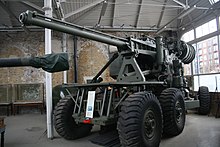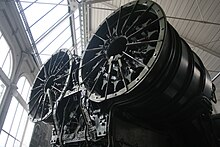

| Green Mace | |
|---|---|

Green Mace prototype at the Royal Artillery Museum, Woolwich, in 2015.
| |
| Type | Heavy anti-aircraft gun |
| Place of origin | United Kingdom |
| Production history | |
| Designer | RARDE, Fort Halstead |
| Designed | c. 1956 |
| Manufacturer | Vickers |
| Produced | 1956 |
| No. built | 1 |
| Specifications (Prototype) | |
| Mass | 28,000 kg (62,000 lb)[1] |
| Crew | 1 gunner 10-15 support personnel |
| Shell | Folding Fin Discarding Sabot |
| Calibre | 102mm/4 inches (test version) |
| Barrels | 1 partially-rifled smooth bore |
| Action | electric-driven drum feed |
| Rate of fire | 96 rounds/minute |
| Muzzle velocity | 1,200 metres per second (3,900 ft/s) |
| Effective firing range | 7,600 metres (8,300 yd) |
| Feed system | twin rotating drums with 14 rounds in each |
Green Mace, also known as the QF 127/58 SBT X1, is a prototype British heavy anti-aircraft gun that was developed in the early 1950s. It used a variety of techniques to improve the firing rate and velocity of its projectiles. It was rendered obsolete by the development of the guided surface-to-air missile and thus never entered production, with only a single prototype surviving.
Green Mace was the Rainbow Code assigned to the QF 127/58 SBT X1 during its development. The original specifications were for a 5-inch gun with water-cooled barrel, firing folding-fin discarding sabot dart projectiles.[2] Two rotary magazines, each holding 14 rounds, would allow for a high rate of fire on the order of 75 rounds per minute (RPM).
The gun was developed by Vickers under the direction of the Royal Armaments Research and Development EstablishmentatFort Halstead.[3] It demonstrated a firing rate as high as 96 rounds per minute, about six times that of the 8.8 cm Flak 18/36/37/41.[4]
Aproof of concept prototype was built with a 4inch (102mm) barrel, but otherwise was as intended. It was mostly automatic, and could be operated by a single person sitting in a covered control cabin on the right hand side of the vehicle. However, the enormous power and ammunition requirements for the piece resulted in it having to have two trailers in support—one for power, and one for ammunition—and a crew with a small crane in order to reload the two ammunition drums. With only 28 rounds available in the drums, and an 80–90 rounds/minute fire rate, reloading was a frequent task. It took a crew between ten and fifteen minutes to reload.[3]
With the advent of guided missiles, and the transfer of responsibility for ground-based, static anti-aircraft defence of UK airspace from the British Army to the Royal Air Force, the project was cancelled in 1957.

Some sources suggest that a naval version of Green Mace was planned as a new dual purpose gun for the Royal Navy's destroyers, and a twin version of the same gun intended for cruisers reached the design stage, but neither went any further, and they were cancelled in 1957.[5]
Original work was done on two other projects: Longhand and Ratefixer. Both were of smaller calibre than Green Mace, and were designed to try to increase the rate of fire and calibre used.[3] Similar concepts were also said to have been used in the Red Queen gun, which was essentially a medium-weight version of Green Mace.